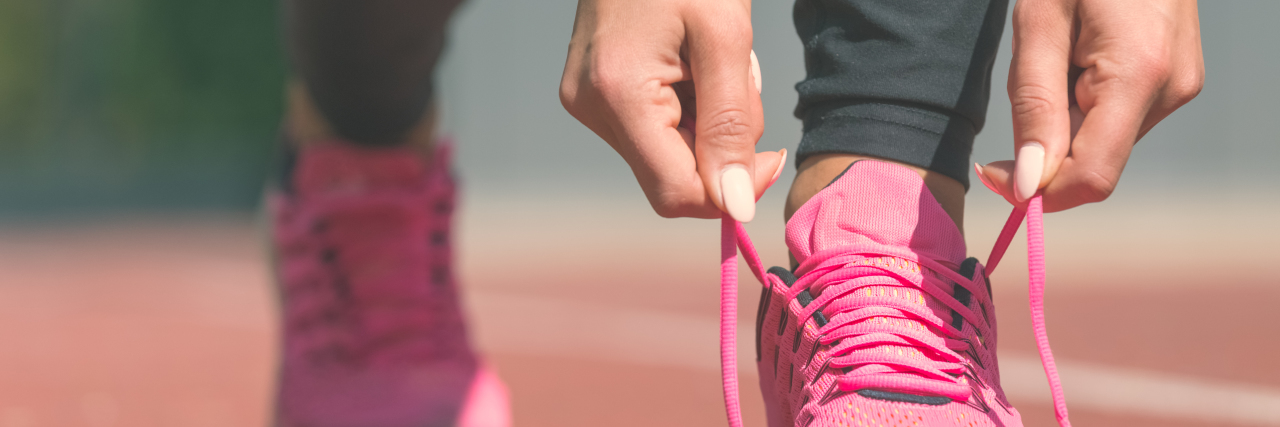One of the most puzzling symptoms I had until I was diagnosed was limited hand dexterity. I knew I had a learning disability and difficulty with math, eye-hand coordination and handwriting. I didn’t realize that having limited hand dexterity was the reason for the difficulty with using my hands.
I felt like I had little control over my hands. I struggled to tie my shoes, write legibly and use scissors. I didn’t learn how to tie my shoes until third grade. I realized styling hair would not make a good future career choice after I gave my doll a disastrous haircut.
I had butterfingers — objects would just slip out of my hand. I was constantly spilling and dropping things. I can remember people saying “There goes clumsy Michelle.” I struggled to catch a ball and would often flinch when the ball would come to me as well. People would tell me not to be afraid of the ball.
My limited hand dexterity makes supporting a newborn’s head difficult. Any time I hold a newborn, I have to use a pillow underneath my hand to support the head. Otherwise, I hold their head at an awkward angle.
My hand dexterity makes everyday fine motor skills difficult. I struggle to lock and unlock doors. I also have difficulty with handling money. My hands have trouble grasping the money in my purse and my dyscalculia gives me trouble with figuring out how much money I have. When I use a debit card, my hands struggle with swiping it and I often forget my pin number. This often makes the cashier and the long line of people frustrated as well.
Limited hand dexterity can make getting dressed difficult. I often struggle with the buttons and hooks on clothing. My husband often has to clasp necklaces for me.
Crafting and sewing can also be difficult with limited hand dexterity. I struggle to thread a needle and find it difficult to sew buttons back on clothing. I did learn to sew when I was in school and thankfully I had a patient Home Economics teacher. I am able to do embroidery but only if the pattern is clearly on the cloth. I can’t count how many stitches I need to make to cross-stitch.
I am also not the best at drawing. I am limited to stick figures and flowers. As a child, I would get frustrated with not being able to draw as well as my peers, and had trouble staying in the lines when I colored. I struggle with folding paper evenly and completing papercrafts. Refrigerator art was never my forte. People would often say unkind things about my projects. I would hear how people with learning disabilities did better in art than academics and wondered why that didn’t apply to me. My husband and friends gently encouraged me to give art another try. I am not talented at drawing, but have found my ability is in photography. I love to snap nature photos of butterflies and flowers.
My limited hand dexterity makes using a stapler and hole puncher difficult. I can’t align the staples and the punched holes symmetrically. I had employers who were not understanding because of my difficulty with stapling and hole punching. Thankfully, modern copiers can make holes and staple documents. I also struggled at work when I had to put holes in art projects or shape play-doh. People would often say “I don’t know why you can’t do this. It’s so easy!”
I also knew that working on an assembly line or having a job working with my hands would not be a good match for me Many people think a person with a disability should take a skilled labor job. When I was diagnosed with hand dexterity and learning difficulties, physiatrists told me I wouldn’t go beyond community college. I was also told that jobs involving communications and writing would exceed my capabilities. The physiatrist recommended skilled and semi-skilled jobs but not professional. I got my bachelor’s degree in Community Programming for Americans With Disabilities. I have many articles published and one of my photographs has been turned into a journal.
I am able to use my hands. I just need to find new ways to use them. I have learned strategies such as typing my work rather than handwriting it. I mastered tying my shoes — it just took me longer and they still have a way of frequently untying. Many clothing designers are now making adaptive clothing for people with disabilities. Modern technology also helps with my limited hand dexterity. I am able to use an electric can opener rather than a manual can opener. Focusing on what I can do is more empowering than dwelling on what I can’t.
Getty image by zoff-photo.

